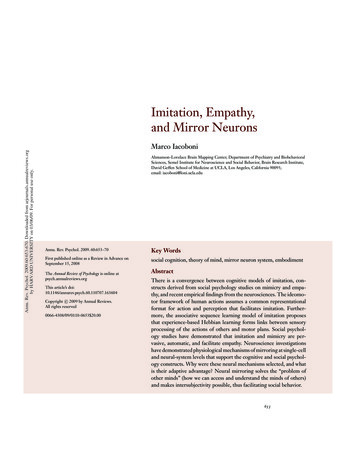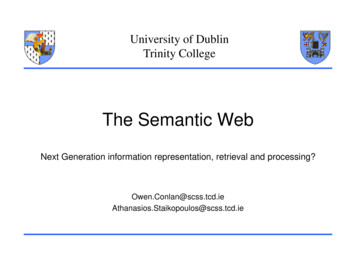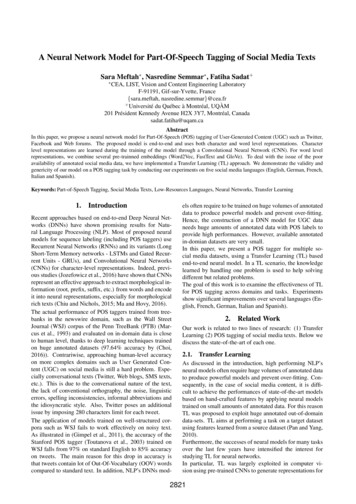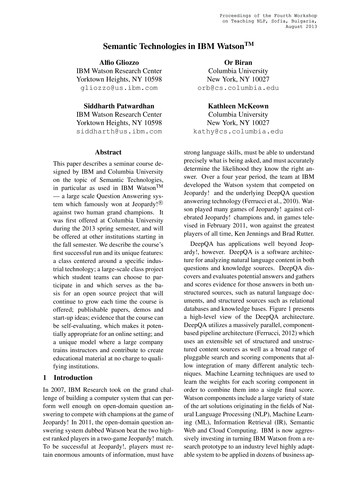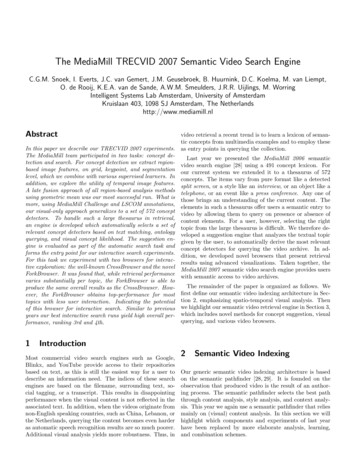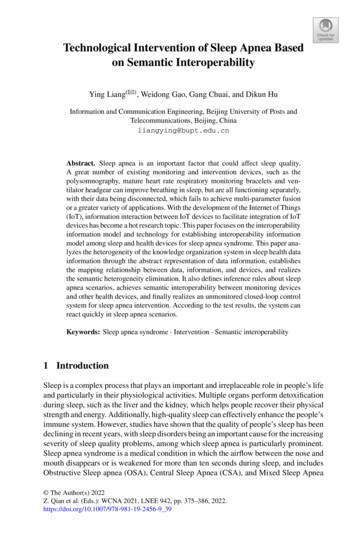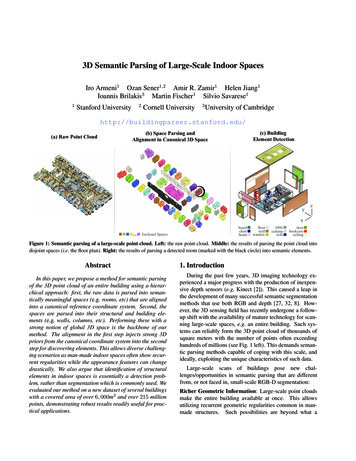
Transcription
Semantic Imitation in Social TaggingWAI-TAT FU, THOMAS KANNAMPALLIL, RUOGU KANG, and JIBO HEUniversity of Illinois at Urbana-ChampaignWe present a semantic imitation model of social tagging and exploratory search based on theoriesof cognitive science. The model assumes that social tags evoke a spontaneous tag-based topic inference process that primes the semantic interpretation of resource contents during exploratorysearch, and the semantic priming of existing tags in turn influences future tag choices. The modelpredicts that (1) users who can see tags created by others tend to create tags that are semanticallysimilar to these existing tags, demonstrating the social influence of tag choices; and (2) users whohave similar information goals tend to create tags that are semantically similar, but this effect ismediated by the semantic representation and interpretation of social tags. Results from the experiment comparing tagging behavior between a social group (where participants can see tags createdby others) and a nominal group (where participants cannot see tags created by others) confirmedthese predictions. The current results highlight the critical role of human semantic representationsand interpretation processes in the analysis of large-scale social information systems. The modelimplies that analysis at both the individual and social levels are important for understandingthe active, dynamic processes between human knowledge structures and external folksonomies.Implications on how social tagging systems can facilitate exploratory search, interactive information retrievals, knowledge exchange, and other higher-level cognitive and learning activities arediscussed.Categories and Subject Descriptors: H.1.2 [Models and Principles]: User/Machine Systems—Human information processing; H.5.3 [Information Interfaces and Presentation]: Group andOrganization Interfaces—Social tagging; J.4 [Social and Behavioral Sciences]: Psychology—Semantic representationGeneral Terms: Theory, Experimentation, Human FactorsAdditional Key Words and Phrases: Semantic imitation, human information processing, cognitivemodels, social tagging, semantic representations, multilevel modelsThis work is supported in part by a grant from the National Science Foundation (0819840), theOffice of Naval Research (N00014-07-1-0903), and the Human Factors Division and the BeckmanInstitute of the University of Illinois at Urbana-Champaign.Authors’ address: W.-T. Fu, Department of Computer Science, Human Factors Division, andBeckman Institute of Science and Technology, University of Illinois at Urbana-Champaign, IL;email: wfu@illinois.edu; T. Kannampallil, R. Kang, and J. He, Human Factors Division, Universityof Illinois at Urbana-Champaign, IL; email: {tgk2,kang57,jibohe}@illinois.edu.Permission to make digital or hard copies of part or all of this work for personal or classroom useis granted without fee provided that copies are not made or distributed for profit or commercialadvantage and that copies show this notice on the first page or initial screen of a display alongwith the full citation. Copyrights for components of this work owned by others than ACM must behonored. Abstracting with credit is permitted. To copy otherwise, to republish, to post on servers,to redistribute to lists, or to use any component of this work in other works requires prior specificpermission and/or a fee. Permissions may be requested from Publications Dept., ACM, Inc., 2 PennPlaza, Suite 701, New York, NY 10121-0701 USA, fax 1 (212) 869-0481, or permissions@acm.org. C 2010 ACM 1073-0516/2010/07-ART12 10.00DOI 10.1145/1806923.1806926 http://doi.acm.org/10.1145/1806923.1806926ACM Transactions on Computer-Human Interaction, Vol. 17, No. 3, Article 12, Publication date: July 2010.12
12:2 W.-T. Fu et al.ACM Reference Format:Fu, W.-T., Kannampallil, T., Kang, R., and He, J. 2010. Semantic imitation in social tagging. ACMTrans. Comput.-Hum. Interact. 17, 3, Article 12 (July 2010), 37 pages.DOI 10.1145/1806923.1806926 http://doi.acm.org/10.1145/1806923.18069261. INTRODUCTIONSocial tagging systems allow users to annotate, categorize, and share Web content (links, papers, books, blogs, etc.) using short textual labels called tags. Tagshelp users in organizing, sharing, and searching for Web content in shared social systems. Some popular social information systems that support tagginginclude del.icio.us and Bibsonomy (for bookmarks),1 Flickr (for photos),2 andCiteULike (for research articles).3 The inherent simplicity in organizing andannotating content in these systems through “open-ended” tags satisfies a personal and social function [Ames and Naaman 2007; Thom-Santelli et al. 2008].At a personal level, customized tags can be added to a resource based on aspecific information goal (e.g., mark up for future reading or identifying booksfor a history library) that will help in organization of resources or future searchand retrieval. At the social level, the tags facilitate sharing and collaborativeindexing of information, such that social tags act as “way-finders” for otherusers with similar interests to search for relevant information [Millen et al.2007; Fu 2008; Fu and Kannampallil 2009; Fu et al. 2009, 2010; Fu and Dong2010a, 2010b; Pirolli 2009; Kang and Fu 2010].Users exploit the open-endedness in the creation and addition of tags insocial tagging systems based on their social or personal needs. However, thisleads to a potential vocabulary problem in social tagging systems [Furnas etal. 1987], as the open-endedness may lead to the creation of a large numberof diverse tags to describe the same resource. Furnas et al. predicted that,because of the lack of top-down control in social information systems, peoplecould use a wide variety of words to describe the same objects, which couldcreate significant challenges for human-system communication. In the case ofsocial tagging systems, Furnas et al. found that users apply “different termsas tags to describe the same resource” by using synonyms, homonyms, andpolysemes, leading to multiple and diverse descriptions for the same resource.The increasing number of vocabularies may imply that the connections betweentags and documents will become less and less distinct, making informationretrieval more difficult.Besides different choice of words, another possible contributor for the vocabulary problem is the diversity of the information goals (i.e., the motivationfor why users are looking for information using the system) under which userscreate tags for resources [Sen et al. 2006; Downey et al. 2008].4 It has been1 http://del.icio.us;www.bibsonomy.org2 http://flickr.com3 http://citeulike.org4 Werefer to the task-specific sense of the term “information goal,” which defines the set of topics orconcepts that the information seeker is interested in when interacting with the system. The broadsense of the term could refer to many other related goals such as emotional or social engagementACM Transactions on Computer-Human Interaction, Vol. 17, No. 3, Article 12, Publication date: July 2010.
Semantic Imitation in Social Tagging 12:3argued that users may use different words to describe the same documentbased on their own interpretation of the content [Furnas et al. 2006], or toserve different information goals of the users. For example, a user may taga book based on its content with a tag “Star Trek”; while another user maytag the same book as “to read,” referring to a personal goal regarding the book;while a third user may tag it as “science fiction,” based on the genre of the book.While all of these tags and the related information goals are acceptable withinthe context of the social tagging system, the relative difference between thesetags in terms of its meanings, purposes, and goals leads to the aforementionedvocabulary problem in social information systems. In other words, the differentcognitive states of the users (induced by their task-specific information goals)may map to the same document through a set of diverse tags that may or maynot be coherent among themselves. Surprisingly, while researchers [Macgregorand McCulloch 2006; Ames and Naaman 2007] have emphasized the potentialimpact of information goals on tagging, there has been no systematic investigation of the effects of information goals imposed by the tasks on social tagging.One possible reason for the apparent lack of focus on the effect of informationgoals is that most previous research on social tagging was based on analysisof a snapshot of the content of an existing system. This approach, althoughrealistic, lacks the control on the diversity of users’ information goals, makingit impossible to study the direct effects of information goals on tagging acrosstime from multiple users.In spite of the vocabulary problem we have described, there has been accumulating evidence suggesting that emergent structures do exist in socialtagging systems [Golder and Huberman 2006; Cattuto et al. 2007], suggesting that the vocabulary problem may not be as detrimental to users to searchfor information as previously suggested. Most importantly, these emergentstructures do seem to have the potential to help users to explore for information by providing meaningful organization and indexing to the informationresources. For example, Golder and Huberman [2006] found that the frequencyof occurrence of any particular tag tended to remain a fixed proportion of allthe tags that were used. In other words, in spite of a large number of usersand an often diverse set of tags, tag proportions remained relatively stablein the social tagging system (i.e., each tag’s frequency is a fixed proportion ofthe cumulative frequency of all tags used). These stable usage patterns areimportant because they partially validate the usefulness of social tags in annotating information content, as it suggests that tags are at least not completely“noisy,” and indeed may act as useful information cues that facilitate information search. The question that remains is: why do these emergent patternsexist?The most generally accepted view on the emergent patterns in social tagsis the “social influence” perspective. Golder and Huberman [2006] used datafrom del.icio.us to show that tag choices are influenced directly by tags createdby previous users for the same resource (a web page in the case of del.icio.us).needs, which we do not focus on in the current article. However, we believe the current model is ingeneral consistent with the social nature of information goals as well.ACM Transactions on Computer-Human Interaction, Vol. 17, No. 3, Article 12, Publication date: July 2010.
12:4 W.-T. Fu et al.They argued that imitation occurs as a result of the presentation of previouslycreated tags to users. Using an evaluation of the del.icio.us and BibSonomytag networks, Cattuto et al. [2007] found that despite the diverse backgroundsand information goals of multiple users, cooccurring tags exhibited hierarchicalstructures that mirrored shared structures that were “anarchically negotiated”by the users. Mostly importantly, they found that some of the patterns weresensitive to the semantics of tags. Specifically, they found that semanticallygeneral tags, such as “blogs,” tended to cooccur more often with other tagsand they tended to stay in the system longer. In contrast, semantically narrowtags, such as “ajax,” tended to cooccur less often with other tags. Cattuto etal. presented a memory-based language model to explain the patterns theyfound. They argued that the emergent patterns in social tags were similar tohow words were naturally used in human communications. The results suggestthat the naturally shared semantic structures among users could be one reasonfor the social influence of tags. In other words, even though people may beusing different words to describe the same document, the underlying semanticstructural relations and contents of these words may be similar, as reflected bythe aggregate patterns of tags in the system.To summarize, previous research seems to suggest that stabilization in tagchoices are caused by two main factors: (a) the information goals of the users(i.e., what the user is looking for), and (b) the social influence of tags (i.e.,how tags created by others influence future tag choices). Although previousmodels did implicitly assume the social influence of tags on other users as themajor reason for the formation of emergent structures in the system, what isstill lacking is direct evidence demonstrating the social influence of tags, andwhat is the nature of this social influence. It is still not clear, for example,whether there are other variables, such as differences in information goals,that moderate the social influence. To this end, we designed an experiment tocompare tagging behavior of two groups of users who can and cannot see tagscreated by others when using a social tagging system.1.1 The Current Approach: From Individual to Social BehaviorIn this article, we present a semantic imitation model to predict the interactive effects of information goals and social influence of tags in a social taggingsystem. The purpose of the model is to investigate the plausibility of semanticimitation as one of the important cognitive processes during social tagging.The model is derived from prior work, based on an empirical investigationof the role of information goals and social influence in the emergence of stable tag usage patterns. Based on predictions of the model, we conducted acontrolled experiment to directly manipulate information goals and the availability of social tags to study their effects on social tagging behavior. We thenanalyzed the behavioral data as well as the network-based data generatedin different experimental conditions to directly test the predictions of themodel.Our study is different from prior research in this domain in two main ways.First, an important contribution of the current study is to understand whetherACM Transactions on Computer-Human Interaction, Vol. 17, No. 3, Article 12, Publication date: July 2010.
Semantic Imitation in Social Tagging 12:5content (i.e., semantics) of tags play a critical role in social tagging behavior.Previous models were primarily based on word-level analyses of the organization of tags (e.g., how likely the same tag was reused across time, or theinformational value/entropy of word-document pairs, etc.). To our best knowledge, there is a general lack of research, analysis, or models that directly studythe relations among the resource contents (meaning) and the semantics of tagsin a social tagging system. Our primary hypothesis is that when a user reads atag, a spontaneous semantic interpretation process will be invoked, which thenprimes (and thus constrains) the comprehension process and subsequently thetag choice process. When users share similar semantic representations, eitherbecause they have similar background knowledge structures (e.g., if they areall biologists or computer scientists) or information goals (e.g., that they are alllooking for books related to a certain topic), their tag choices may tend to converge, leading to emergent behavioral patterns observed in large-scale socialtagging systems. Therefore, even when the user is not reusing the exact sametag, he or she may still be influenced by the existing tags at the semantic level,and thus create tags that are semantically related to the existing tags. We willpresent details of this model in the next section.Second, we believe that much could be learned by assuming that in a collaborative system such as a social tagging system, an essential part of usercommunications occurs at the semantic (concept) level, much like the level ofrepresentations in most other communication methods among humans (e.g.,we may use seemingly arbitrary symbols/sounds to communicate, but the semantics to which these symbols refer to tend to be relatively consistent withingroups/cultures). Therefore, we believe that by including the semantic levelin the analysis, one could gain much insight into the complex interactionsamong the users and the social tagging system. In fact, we believe that amodel that includes cognitively plausible representations of tags, resources,and processes will be essential for understanding individual behavior, as wellas how they may provide reasonable constraints for understanding the dynamicemergent behavioral and network patterns observed in a social informationsystem.Although there has been much work done in the analyses of fine-grained individual human-computer interactions on the one hand and aggregate behavioralpatterns of large-scale social information systems on the other, research thataims at bridging the gap between the two is scant. We believe that the currentmodel will be useful in bridging this gap, which is critical for explaining howdifferences in individual behavior will lead to different emergent behavioralpatterns, and is essential for providing concrete guidelines for designing interface representations and interactions methods to achieve the desirable “social”effects of these systems. One should note that although emergent patterns in asocial information system reflect the aggregate behavior of a massive numberof users, when individual users interact with the system, the interactions areinherently “local,” in the sense that factors that influence individual users arestill much influenced by the interface representations and interaction methods experienced by each individual user. Thus, most higher-level emergentACM Transactions on Computer-Human Interaction, Vol. 17, No. 3, Article 12, Publication date: July 2010.
12:6 W.-T. Fu et al.behavior in the system can be traced back to the aggregation of distributed “local” computations occurring at the individual levels [Anderson 2002; Hedstrom2006]. In other words, a better understanding on the local interactions at theindividual or small-group level will provide a solid theoretical foundation forexplaining aggregate patterns at the social level.To summarize, our approach is different from most of the prior research onsocial tagging systems: (a) we attempt to demonstrate not only the existenceof the social influence of tags, but also the nature of the influence using apsychologically plausible mechanism that explains behavior at the individuallevel, and (b) we use a human information processing perspective to reporton how individual semantic representations influence the choice of social tags,and how they explain aggregate behavioral patterns in social tagging systems.As opposed to prior research that uses large corpuses of tagging data to reporton properties of overall tagging behavior, our approach is to conduct a laboratory experiment to study the role of semantic structures in tagging behavior,(c) we directly manipulated the information goals (which would be impossibleto ascertain during the analyses of corpora tagging data) of taggers to studytheir effect on the social tagging process, (d) we directly study the social influence of tags by comparing effects of tag choices from a social group (wheretags are visible to other users) to a nominal group (where tags are not visible to other users), and (e) we use a novel comparison between social networkproperties (such as connectedness and tag cooccurrences, [Albert and Barabási2002] and statistical measures of tag semantics (Latent Semantic Analysis,[Landauer and Dumais 1997]) as a baseline for establishing the emergent semantic knowledge structures in the social tagging networks created by theparticipants in the study. At the outset, we want to stress that our goal is notto show that our model is exclusive of previous models or theories on socialtagging. In fact, quite the contrary, we believe that alternative theories andapproaches, especially from a cognitive perspective, will help us in developingdeeper insights that will complement our current knowledge of social taggingsystems.2. BACKGROUNDIn this section, we will first describe the role of semantic interpretation in social tagging and then we introduce the semantic imitation model. The formaland graphical representations of social tagging systems adopted in the current analyses are then described. These representations allow measures andcomparisons of the structural relationships among users, tags, and resourcesbetween social tagging systems. We will then describe how these network representations can be applied to test the predictions of the semantic imitationmodel.2.1 Semantic Interpretation of Social TagsAn intriguing feature of social tagging systems is that they can be consideredplatforms for dynamic interactions of diverse semantic structures among users[Cattuto et al. 2007; Fu et al. 2009]. It is therefore intuitive to assume thatACM Transactions on Computer-Human Interaction, Vol. 17, No. 3, Article 12, Publication date: July 2010.
Semantic Imitation in Social Tagging 12:7tag choices are influenced not only by existing tags, but also by the semanticinterpretation of tags and the associated content by the users. By assumingthat semantic interpretation will influence tag choices, one can broaden theanalysis by going beyond the statistical structures within the system to includethe active role of individual users. Indeed, if features of social tagging systemscan influence higher-level knowledge structures of users, social tags may notonly provide annotation to web contents, but they may also have the potentialto play an active role in facilitating exchange of knowledge structures amongusers [Fu 2008; Fu et al. 2009, 2010].There has been a long history of research on semantic interpretation in theresearch areas of reading comprehension and information extraction. Researchon reading comprehension assumes that as a person reads text, words invokecorresponding semantic representations to allow the person to extract meaningful information contained in the text [Kintsch 1998]. This kind of spontaneoussemantic interpretation of words is perhaps best illustrated by the experimentson “false memories” [Roediger and McDermott 1995]. A typical false memoryexperiment would show that when people were asked to remember a list ofsemantically associated words that converged on a nonstudied word, peopletended to falsely remember the nonstudied word. For example, after studyingthe list consisting of thread, pin, eye, sewing, sharp, point, pricked, thimble,haystack, pain, hurt, and injection, people often erroneously recalled the converging nonstudied word needle in the list. This kind of “memory illusion” isoften interpreted as evidence supporting the notion that as people process alist of words (or tags, when they are browsing a social tagging system), theyspontaneously activate the corresponding semantic representations for thosewords. When people try to recall the list of words, the converged semanticrepresentation will again be activated to exert a top-down influence on memory recall. As the false-memory experiments showed, because the nonstudiedword was representative of the converged semantic representation, it was oftenerroneously “recalled.”Results from these experiments demonstrate that people tend to naturallyencode semantic representations of words during comprehension. In fact, thesemantic representation of information is often taken as one of the major defining characteristics of human information processing, as significant informationreduction can be achieved only when the most “critical” information is stored inour memory system [Anderson 1974]. This kind of semantic abstraction has along tradition of being the most commonly accepted forms of knowledge representation in human information processing [Anderson 1974; Frederiksen 1975;Norman and Rumelhart 1975; Kintsch 1998]. The implication is that the critical level of analysis of human communication is often not at the word level, butat the semantic level at which meanings are communicated, interpreted, andexchanged. This is also one of the major differences in the way how humansand machines index information: Humans tend to abstract away details at theword level to spontaneously derive the semantic representations of words whenindexing information in the world, while machines tend to process at the wordlevel to derive the associations between word and documents/objects in theworld.ACM Transactions on Computer-Human Interaction, Vol. 17, No. 3, Article 12, Publication date: July 2010.
12:8 W.-T. Fu et al.2.2 A Semantic Imitation Model of Social TaggingThe semantic imitation model for social tagging consists of two important components: a topic inference process and a topic extraction process.5 As the usernavigates through a social tagging system, while searching for content, tagscreated by other users will help them interpret whether a particular resource(e.g., a bookmark) is relevant to his or her current information goals. The set oftags assigned to the bookmark will act as retrieval cues for relevant topics (orconcepts) represented by these tags. We call this the tag-based topic inferenceprocess. For example, consider a resource, a URL from WebMD on Obesity. Itis likely that the associated tags for this URL could include a tag “health.” Onseeing this tag (i.e., “health”), the user can be semantically primed to thinkabout related tags such as nutrition,” “diet,” or “exercise.” This inference process based on the interpretation of tags associated with a resource is referredto as topic inference. Thus, the process assumes that the topics inferred fromthe tags will allow the user to predict the information content of the associatedresource, as well as to provide some form of semantic priming of related concepts when the user processes (comprehends) the information in the resource[Kintsch 1998].The second stage is the topic extraction process. It is assumed that the userextracts the concepts (topics) that describe the contents of the document. Thetopic extraction process is influenced (i.e., biased) by the initial tag-based topicinference. In effect, during comprehension, the user combines the topics fromthe document and those extracted from the tags (created by previous users).We assume that when a user processes a resource, he or she will engage in aprocess of topic extraction to comprehend the associated information content[Pirolli 2004; Fu 2008]. Associated information content can include abstracts ofpapers (in CiteULike) or overviews of Web URLs (del.icio.us), or the completecontent of a Web page. Following from the discussions above, semantic primingbased on existing tags may bias the user during topic extraction from thedocument. Specifically, the model assumes that topics activated by existing tagsmay prime users to allocate more attention to related topics when they processthe associated resources. Thus, with all else equal, the topics extracted will bebiased to topics that are semantically primed by the tags that are currentlypresent in the resource. Assuming that users will assign tags to best representthe topics extracted from the resource, the model predicts that tag choices willbe semantically similar to existing tags. This process of topic extraction has along history in the literature on reading comprehension and human memory[Anderson 1974; Kintsch 1998]. This process is shown in Figure 1.The initial tags (T1 , T2 , T3 ) induce a process of tag-based topic inferenceresulting in the identification of three topics (or concepts): C1 , C2 , C3 (i.e.,topic inference). The user then interprets the actual contents of the resource.The process of identifying the topical contents of the resource document isinfluenced by both the user’s understanding of the content and by the topicsidentified in the tag-based topic inference process. The end result of this process5Amathematical version of the semantic imitation model can be found in Fu et al. [2009].ACM Transactions on Computer-Human Interaction, Vol. 17, No. 3, Article 12, Publication date: July 2010.
Semantic Imitation in Social Tagging 12:9Fig. 1. A model of semantic imitation in social tagging. The model assumes that existing tagswill invoke a tag-based topic inference process, which will bias the extraction of gist from theresource and semantically prime the later tag choice process. The effect of information goals on thegist extraction process is mediated by the semantic interpretation of existing tags. In the figure,existing tags (T1 , T2 , T3 ) act as cues for related topics (C1 , C2 , C3 ) in the topic inference process,and later lead to extraction of gist concepts Cw , Cx , C y , and Cz .is a set of concepts (Cw , Cx , C y , Cz ) that influences the tag choice (T A, T B, TC , T D )of the user. The current model of semantic imitation aims at extending existingmodels of social tagging by assuming that semantic interpretation of tags playsan important role in the users’ tag choice behavior. In fact, word imitation canbe considered a special case of semantic imitation, in which one can assumethat the exact word is reused to represent the same semantic content (whichclearly is a more restrictive model).In addition to semantic representations of tags, another major assumptionof the model is that the interaction effect between information goals and thesocial influence of tags in the topic extraction, and eventually, the tag choiceprocess. Prior research has shown that information goals did show a stronginfluence on tag choices [Ames et al. 2007]. For example, if a user is browsingfor books about retirement, he or she may be biased to extract topics that aremore relevant to retirement (such as health, travel, etc.) and assign tags thatare directly related his or her information goal.An important prediction of the semantic imitation model is that the dynamicinteraction between the influence of semantic representations of tags and information goals on tag choices. When users can see tags created by oth
Organization Interfaces—Social tagging;J.4[Social and Behavioral Sciences]: Psychology— Semantic representation General Terms: Theory, Experimentation, Human Factors Additional Key Words and Phrases: Semantic imitation, human information processing, cognitive models, social tagging, semantic representations, multilevel models


